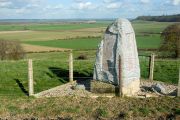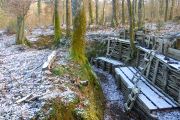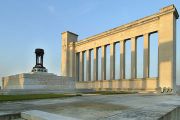The Marne was one of the main battlefields of the First World War. Numerous monuments and sites immortalize the memory of soldiers from France, America, Germany and elsewhere who fought there and were killed. It’s a similar story in the neighbouring department of the Meuse. This year several events are planned to celebrate the 90th anniversary of the Armistice.
[ Practical ]
- Getting there
By road
145 km from Paris to Reims on autoroute A 4. Suippes is 40 km further and the Argonne 90 km further.
By train
TGV Paris Gare de l’Est – Reims (45 mn)
- Good to know
To get to the battlefields and the monuments it’s necessary to have a car.
- Hotels - restaurants
Le Tulipier in Vienne-le-Château
La Source du Py in Sommepy-Tahure
Le Cheval Rouge in Sainte-Menehould
- Les Sentiers Scènies de Sommepy-Tahure
0326682164
www.sentiers-scenies.com
- Centre d’Interprétation de Suippes
0326682409
www.marne14-18.ff
- Verdun, son et lumière « Des Flammes à la Lumière »
0329845000
www.connaissancedelameuse.com/
- Information about commemorations and events
www.champagne1418.net
www.offensives1918-meuse.com
- General informations
CDT des Ardennes
0324566773
www.ardennes.com
CDT de la Meuse
0329457540
www.tourisme-meuse.com
CDT de la Marne
0326683752
www.tourisme-en-champagne.com
Only 130 km and less than one hour from Paris by train, the Marne is known by all tourists for its champagne and for Reims, the city where kings once came to be crowned in its magnificent cathedral which remains one of the most beautiful religious buildings of France.
 Battles of the Marne Battles of the Marne
But, in this 90th anniversary year of the end of the First World War it is good to remember that this department was also one of the main battlefields of the conflict. Twice the Germans were stopped there trying to reach Paris, in what became known as the battles of the Marne. The first time was in 1914, and, in Mondement, South of Epernay, a 35 m high ochre concrete standing stone marks the extreme point of the invasion blocked by French reinforcements brought from Paris by taxi !!!
East of Epernay, in Dormans, in the valley of the Marne, the " Chapel of Victories " overlooks the spot where the Germans crossed the river both in 1914 and in 1918. During this second offensive, attacks were carried out on both sides of Reims which resisted, notably thanks to the Fort de la Pompelle, today transformed into the Museum of the Great War.In Bligny, about fifteen km to the southwest, more than 4 000 Italian servicemen who died on this occasion are buried.
 Marines first major action Marines first major action
Very violent confrontations also took place in the nearby department of Aisne. It’s there, in Oulchy-le-Château, on the Butte Chalmont, that a moving sculpture by Paul Landowski stands; called “The Ghosts”, it honors all the units that participated in this battle. Near by are also two American military cemeteries, one in Fère-en-Tardenois, the other in Belleau, where the Marines, commanded by General Hartwood, experienced their first major action and established their reputation for bravery. An episode commemorated by a monument near Château-Thierry.
Between these two dates, in the Marne, as everywhere else, the conflict sank into trenches and the front only moved a few km in either direction at the price of tens of thousands of lives.

 Saint Hilaire le Grand © T.Joly Saint Hilaire le Grand © T.Joly
|
 Russian cemetery Russian cemetery
Numerous French and German cemeteries are there to testify to this butchery, but many people of other nationalities also died in the plains of Champagne. Thus, in Saint-Hilaire-le-Grand, in the middle of a little wood an Orthodox Church and a Russian cemetery are hidden. Irony of History, when the 1917 Revolution exploded, this expeditionary force split between pro-Communists and pro-Czarists and the French army had to intervene to prevent them from killing each other !!!
In Suippes, east of Reims, which was located near the front line, a very interesting Center of Interpretation presents all the armies of the Nations which participated in the battles in the region while giving instructive explanations about the evolutions of the front and the weapons used. Among them the United States which were present in the War through volunteers well before the arrival of their army in 1917.
 In memory of the legionnaires In memory of the legionnaires
Thus in the nearby military camp there is a monument set up by an American family in memory of their son Henry Farnsworth and his legionnaire comrades who died in the 1915 fighting. If you wish to see it do not miss this coming November 11th. On the occasion of the celebration of the Armistice, the military camp will exceptionally be opened to the public who will also be able to discover the ruins of villages destroyed during that war and never rebuilt. Always in the same area, there once stood a farm called Navarin where the poet Blaise Cendrars lost a hand in 1915, the same day Henry Farnsworth was killed. Being right in the middle of the front line for months it was razed to the ground and now, on the same spot, rises the ossuary of Navarin which shelters the remains of 10 000 soldiers. In the crypt rests General Gouraud who commanded this sector and who asked to be buried with his men. He also served as model for one of three soldiers' sculptures which top the monument. The one in the center.
 Memorial bridge Memorial bridge
As for the fighter armed with a machine gun who is on his left, he has the face of the aviator Quentin Roosevelt, son of the President of the United States who was shot down in July 1918. This was the year the American troops really began to participate in the fighting and they played a decisive role in the final victory. Several monuments or steles commemorate the deeds of armed units or individuals. In Fismes, in the north-west of the department, right by Aisne, the State of Pennsylvania erected a memorial bridge bearing lanterns to honor the dead and statues of Liberty and Peace which commemorate the recapture of the town by the 28th Division in August – September 1918. A unit that may at one time have been commanded by General Custer, which would explain the engravings of buffalos decorating the base of the lanterns !!! 4 km away, in Courville, in a region where abbeys abound, a fountain was built by William Russel's family, a pilot who died in August, 1918 and is buried in the village cemetery.

 Freddie Stowers Monument © T.Joly Freddie Stowers Monument © T.Joly
|
 A stele in the middle of the field A stele in the middle of the field
Once the German lines were penetrated, the north of the Marne was another area where American troops won fame. Sometimes at the price of heavy casualties like on the mound of Blanc Mont, near Sommepy-Tahure where there is now a cemetery and a memorial in their honor. From its summit there is an excellent view over the battlefield and it’s still possible to make out the former German trenches. Closer to the Ardennes, on the territory of Grateuil, near the farm of Bussy, a simple stele in the middle of the fields reminds visitors of the heroism of Freddy Stowers, who in 1991, posthumously became the only Black American soldier of the First World War, to have received the Medal of Honor, the United States’ highest military distinction. It was the survivors of his unit, the 371st Regiment of Infantry, who paid for this stele in memory of this man and his companions who died in late September, 1918.

 Camp de la Vallée Moreau © T.Joly Camp de la Vallée Moreau © T.Joly
|
 German camp German camp
The American troops also led big offensives in Argonne, a rugged and woody region located in the North-East of the Marne. An area the Germans had well strengthened as shown by the camp of the Vallée Moreau, North of Vienne-le-Château, in the wood of Gruerie. Half buried in a hill, as a protection against shelling, it was restored by volunteers and constitutes an almost unique example of a fortified camp. A little further on, between Blainville and Charlevaux, a boundary stone standing on the right of the road indicates the valley where 8 units of the 77th American Infantry Division were surrounded by the Germans for several days and lost most of their men. The famous episode of the Lost Batallion, immortalized by a film as early as 1919.

 Site action du Sgt York © T.Joly Site action du Sgt York © T.Joly
|
 Sergeant York Sergeant York
Another famous story a few km to the North, in the Ardennes, is the place where Sergeant Alvin York became one of the most well known heroes of the United States. In Chatel-Chehery, where a commemorative plaque is dedicated to him in front of the city hall. It was just beside this village, in what is now a peaceful hilly landscape where on October 8th, 1918 this native of Tennessee led an attack during which 32 machine guns and 132 Germans were captured. An exploit which led to him becoming the most decorated American soldier of the First World War; a 1941film starring Gary Cooper tells his story.
Argonne also extends over the department of Meuse, quite close by, where there are also several sites related to the First World War. In Romagne-sous-Montfaucon is Europe’s largest American military cemetery with 14 246 soldiers buried in its compound.

 Argonne Monument © M.Petit / CDT Meuse Argonne Monument © M.Petit / CDT Meuse
|
 American offensive in Meuse American offensive in Meuse
In Montfaucon d' Argonne, a monument dominated by a more than 60 m high Doric column topped by a statue of Liberty commemorates the American offensive in Meuse - Argonne in Autumn, 1918. A region where violent fighting had already taken place at the beginning of the war. In Lachalade, a monument perpetuates the memory of both Garibaldi’s two grandsons, Bruno and Constant, killed in December and January, 1915, as well as 500 Italian volunteers who came to fight beside France. In addition, near this town is the Kaiser Tunnel, a network of 455 m of subterranean galleries dug by the Germans which sheltered a hospital, a power plant and a telephone exchange. Those who want to learn more can go even further East to Verdun, site of the most famous battle of the War.
 Rebuilt thanks to donations Rebuilt thanks to donations
Moreover south of this city is another American cemetery, in Saint-Mihiel, as well as a commemorative monument, in Montsec, both reminding visitors of the first solo offensive and victory of American troops commanded by general Pershing, in September, 1918.
But the assistance of the United States to France continued after the end of the war. In Marne, the village of Sommepy was able to be reconstructed thanks to donations that one of its inhabitants, Lieutenant Lhuillier went to collect in several East Coast States by giving speeches. In the city hall, a small museum retells this story and every summer a nocturnal audio video walk through the village depicts its history and that of its inhabitants before, during and after the war. Another example is the hospital for the children of Reims which was built in the 20s thanks to American funds; the names of the donors can still be seen on the walls of the rooms as well as the original frescoes.
May 21, 2008
Thierry Joly 

|



